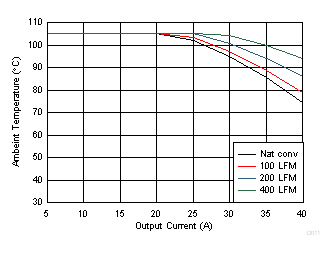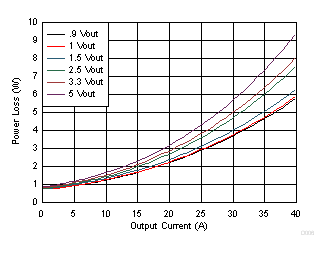SLVAEG2A August 2019 – May 2021 LM10011 , TPS53515 , TPS53915 , TPS543B20 , TPS543C20A , TPS54424 , TPS544B20 , TPS546D24 , TPS546D24A , TPS54824 , TPS548A20 , TPS549A20 , TPS549B22 , TPS549D22 , TPS54A24
3 High Efficiency and Thermal Performance
Depending on form factor constraints, hardware accelerators are built on circuit boards with many PCB layers. Since the hardware accelerator is typically designed for use in tight spaces, special attention must be taken in selecting DC/DC converters to ensure the application operates in thermally challenging environments with the available airflow. This is displayed in the SOA curve of Figure 3-1, and the power-loss plot in Figure 3-2, the TPS543C20A DC/DC converter delivers 40-A and 1-V output with an ambient temperature of 75°C without airflow. At 25-A, 12-V input and 1-V output, the entire solution dissipates less than 3 W, which translates to around 90% efficiency when switching at 500 kHz. The TPS543C20A measured junction-to-ambient thermal resistance is 12°C/W based on a six-layer, 2-ounce Cu per layer, and 2.75 inch by 3-inch board size, which demonstrates low thermal resistance. However, many thermal metrics exist for semiconductor and integrated circuit packages, which range from RθJA to ψJT. Often, designers misapply these thermal metrics when trying to estimate the junction temperatures in a system. Ultimately, thermal performance depends on the circuit board layout and using standard, JEDEC-referenced thermal numbers (1).
 Figure 3-1 TPS543C20A SOA Curve
Figure 3-1 TPS543C20A SOA Curve Figure 3-2 TPS543C20A Power Loss
Curve
Figure 3-2 TPS543C20A Power Loss
Curve